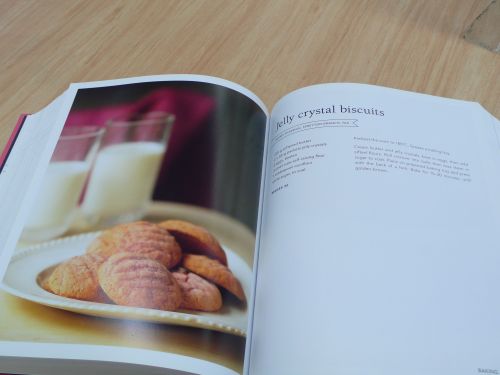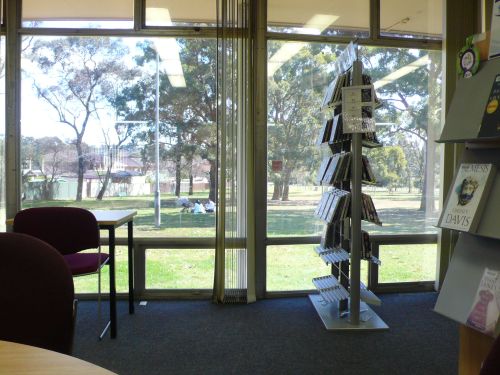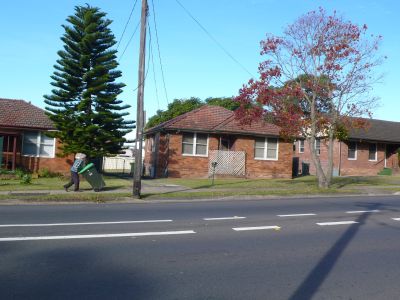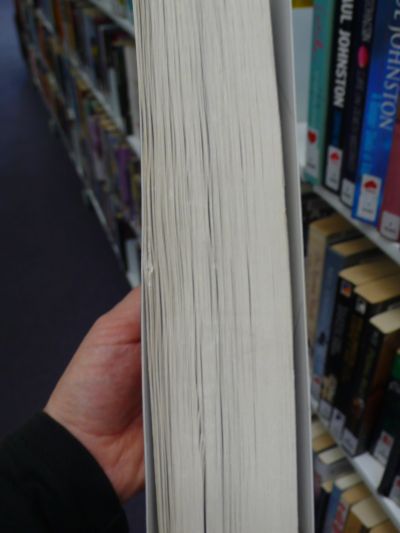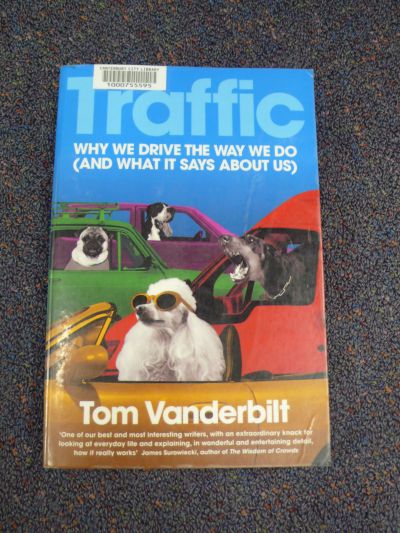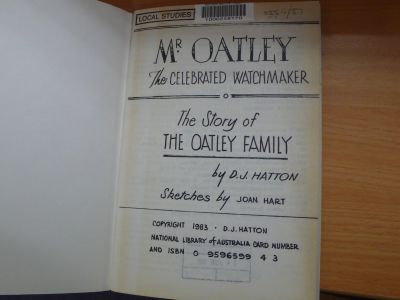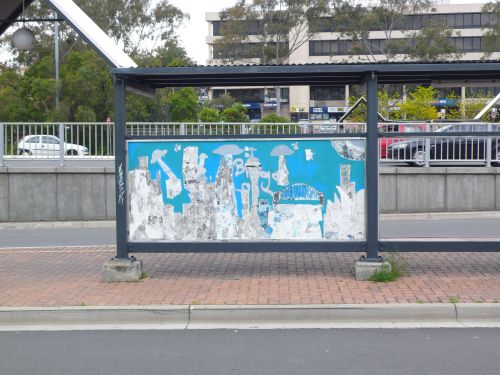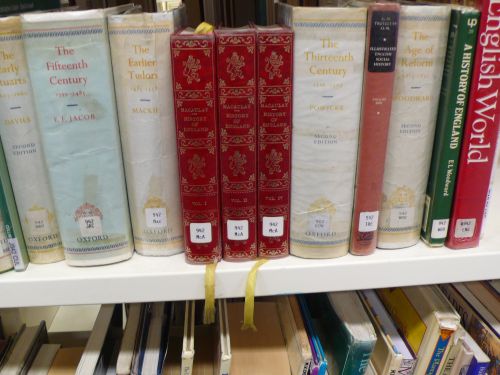Upon stepping into the Padstow library, eager to read the announcements on the community noticeboard that faced the entrance, I was accosted by a woman. She had a newspaper folded under her arm, and was on her way to the toilet cubicle that lay to the right of the entrance. Throughout our conversation she went as if to go into the cubicle, but then would come back with another question.
She was interested in my clothes, my stockings in particular.
“Grass green stockings! They’re a real grass green. Have you been rolling in the grass?” she asked.
I looked down. I would have called my stockings sickly olive, rather than grass, but she marvelled over their colour so much I thought it wise to agree.
“No, but they are grassy.”
“Where did you get them from?”
“An op shop, ” I said, wondering if this answer would disappoint her.
“Were they new?” she asked.
“They were still in the packet, but they were from the 80s judging by the packet design.”
“Oh yes, I understand. They look great with those shoes,” she said, indicating my black Mary Janes, “Where are they from?”
“Melbourne.”
“I’m a Melbourne girl – though I’ve lived here for 30 years. Where in Melbourne?”
“Collingwood.” I wondered how specific this was going to get.
She started to sing what I imagine must be the theme song of the Collingwood Magpies before breaking off to say “actually, I’m from Carlton”.
She goes on to review my outfit from the feet up.
“I don’t like the skirt.”
“It’s a dress,” I said, “so there’s more of it to hate.”
“It would be better with a black skirt – or shorts – and a black turtleneck, The sunglasses are good too, where are they from?”
“Japan,” I said, feeling awful, like one of those people whose trendy outfits get dissected in magazines. I was a cliche just like them, with my mixture of things from op shops, things from boutiques (though it was just the shoes, I never buy clothes new) and something I bought in another country.
“Yes,” she said, “I saw you straight away, if you wear all black with the grass green stockings, it will be a great outfit. A real grass green,” she continued to wonder, as she finally went into the bathroom with her newspaper.
I turned to enter the library to the stares of the people using the computers nearby. Having never been to Padstow library before, I hadn’t realised that my conversation would have been loud and distracting to anyone inside the small library, just metres away.
Suitably embarrassed, I quickly sat at one of the study tables and got out my books and my computer, ready to do some work.
I had been to Padstow once before, out of curiousity, seeing it on the front of a bus on a day when I was out op shopping. In search of the library I’d gone over to the side of the station where the op shops are (or were, one had gone, leaving only the little old Red Cross store, which was empty apart from the voices of the women in the back room, talking about nursing homes) thinking the library was there. Actually, it was on the other side of the station, in a park, beside a little Early Childhood centre, many of which must have been built in the 1950s – 1970s, in the same drive towards civic architecture which produced many of Sydney’s branch libraries.

The Padstow library is a pale brick building, with big mirrored windows that reflect the street. From the inside, though, you can look out at the cars and people going past through these windows, as you sit at one of the study desks.
Sitting in front of me was a boy with geometrical designs on his hoodie, studying maths, and in front of him, a girl studying Chinese history. She was established at her table, a constellation of useful objects – books, pencils, water bottle, hairbands, stationery – surrounded her. I had work to do also, but any work I did was interspersed with close study of the library and its atmosphere.
Padstow library has a lot of indoor plants, which makes the library feel comfortable, like a living room. The plants are in pots on top of the shelves, among the announcements for things like the Seniors screening of Sweeney Todd. At the end of some of the shelves of books were collages promoting Fantasy books, with reading mermaids and flying books.
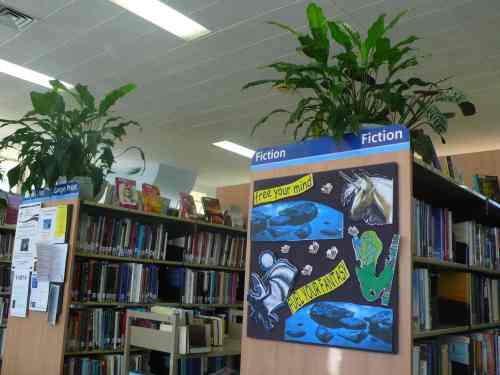
I watched a girl with a long long plait browse the fiction shelves, a copy of The Arrival under her arm. Another woman was looking at the New Age section, pulling out a book called “Mythology of the Incas” and staring at the cover for a long time, before selecting a book about women’s empowerment by Louise Hay. Louise Hay, queen of affirmations, comes up in our house sometimes, as I recall particular parts of her most well known book, You Can Heal Your Life, where she talks to herself in the mirror every day with loving affirmations, and, if she does get angry, takes it out on a pillow. I think Miranda July has read some Louise Hay books, they weirdly remind me of each other although one is a self help guru and the other is an artist.
Outside the library, two teenage girls were walking past. They were wearing matching outfits: cut off shorts and singlets, with big collared shirts over it all. One girl had a packet of Twisties in her hand, and a half eaten Twistie in the other. I wondered where they must be going, but they were just wandering, as a few minutes later they walked back across, stopping to preen in the mirrored surface of the library’s window, unable to see me staring out at them from behind it.
It was school holidays and kids were everywhere. On the train, as I travelled along the East Hills line (the train line of Sydney I’ve had least experience with), I watched two kids clinging to a wire fence that separated the train tracks from a playground. I had wanted them to wave, and was ready to wave back, but they were caught up in their own private world, the fence the boundary to some game. Then I felt afraid of school holidays, and wondered whether this would impact on the libraries and their peacefulness.
No, it turns out. Apart from the two teenagers in front of me, there was one other girl, studying at the opposite end of the library. She looked as if she were suffering, every few seconds lifting her head from her page and sighing, casting looks of despair out to the rest of the room. A number of times I caught her eye and quickly looked away, in case I was afflicted with her lassitude. It had been a while since I’d seen such pure boredom, although some of my students come close sometimes. Occasionally one of mine will even fall asleep though, which I guess is the apex of boredom.
By contrast, I was very busy. I typed away at my computer, working for a while before packing up and going to inspect the shelves. Like many public libraries, the books had stickers on their spines to show their genre. I particularly liked the Mills and Boon section. This library also had a vast Large Print section, revealing, perhaps, the demographic who borrow most.


The shelves that lined the walls were illuminated by lights, above which were the subject you could find on that particular shelf. The Animals section was larger than I thought it would be, although having looked in one of Sydney airport’s bookshop a few weeks earlier, I had been surprised by the size of its animal section – there are a lot of books written about animals. The only books I have read about animals are Alex and Me by Irene Pepperberg (about the genius African Grey parrot) and Tarka the Otter by Henry Williamson. If I ever want to look into the topic further however, there are plenty more. The most common animal books seem to be about dogs, cats, lions and monkeys. Perhaps there is an opening for me to write a book about the bond between me and the rabbit here.
I tore my eyes away from Bonobo Handshake by Vanessa Woods and went to set up a position at the other end of the library, near the bored girl. Here, rather than the small, windowside individual study tables, were large tables that could seat a number of people. There were also red baskets, with the sign “Customer Baskets, for your convenience”, which made me think of the supermarket. This library did have a number of things on sale, including library bags and bookmarks, but the baskets were for books. No one who I saw enter picked up one of these baskets.

From this position I could see the screen of the man who was sitting at one of the computers. He was going through the practise driver knowledge test that you have to do prior to getting your learner driver’s license. Having done one of these myself not so long ago (I have done this test a number of times, and passed it every time, got a learners license, then failed to learn to drive). This man didn’t look like someone who needed to learn to drive. He was a tanned, stocky man in his forties, with a thick neck and tribal tattoos on his arms, but maybe people look at me and think I look like I know how to drive too – what does a driver look like?
I watched him for a while: the clunky graphics of this test, the kind that makes you feel stupid because the buttons you have to click on are so large, was easy to read from across the room. The whole time I’d been in the library, a woman had been bustling around, straightening the shelves and putting back books. For an hour she had done nothing but this, although the library was already in impeccable order. The room resounded with the clop – clop sound of books being rearranged on shelves from her manic shelf-straightening.
The other staff were in the rooms behind the counter, access to which was through a doorway with a KEEP READING sticker on the lintel. Painted on the glass panel above this were the words Fuel Your Mind (fuelling, freeing, the library is a busy place for the mind).
I looked down at the book of Japanese cookery open on the table in front of me. Having been in Japan and eaten all sorts of delicious and curious things, I was eager to try to cook some of these things on my own. This book was big and heavy with large colour photos of each dish. In general I prefer cookbooks without photographs, so what you are cooking remains somewhat a mystery, but these are harder to find. I chose one recipe that seemed appealing and thought about transcribing it, until I read:
This sticky rice dish, sekihan, is cooked for special occasions and takes 8 hours to prepare.
Eight hours! As I marvelled over this, the man on the computer got a call on his phone. His ringtone was a wild, funky explosion of music and he took his time in answering.
“I’m in the library practising my test… I’m kicking bum… What happened over the road with the coppers?”
I listened avidly, but there was no clue in his next comment as to what the coppers had been doing.
I’d been wondering how he was going on his driving test – it was good to know he was kicking bum. He’d been working his way through it slowly, reading every word on the screen carefully. I decided that I would stay in the library until he finished it, before I moved on.
It was 1:50pm, the time that seems to come in every library (although the actual time is different in different libraries) when the men come to the library. “Man Time”, I call it. Old men, in caps and bright cable knit jumpers. Young men, wanting computer access. Men who know the librarians personally and are after books about coin collecting.
I stopped gawking at everyone in the library and concentrated on the book I’d picked out from the shelf, “365 Everyday Games and Pastimes” by Martin and Simon Toseland. I like looking through such books, although in actual fact I hate playing games. Word games are the worst, compounded by the fact that, because I’m a writer, people expect me to enjoy them. This is not an unreasonable assumption, but my trouble with them is that they make my mind freeze up, like sometimes when I have to spell words aloud. Added to my lack of competitiveness – oh, so you want to win this game of snakes and ladders? go right ahead – I’m a sourpuss when it comes games time.
I don’t want to be like this, somewhere in my fantasies is the image of a smoky night in the 1930s, where a version of myself and my fantastic friends drink brandy, smoke, and play party games to our hearts content. In the book I read about the word game called “Buried Names”. In this game, you bury a name of a famous person in a sentence. The example given was:
One DAy I was watching a VIDeo when I was BECKoned into the kitchen by my mum, who asked if I wanted a cheese or HAM sandwich.
You read this sentence out and people have to guess whose name is buried in the sentence. On paper, I found this interesting, but it would drive me crazy if I were to be asked to play this, especially if liquor was involved. All I ever want to do when drinking is talk on and on, and listen to records.
Another book I investigated was a collection of quotes about books. I looked in the index to see what kind of quotes there were about libraries.

As I scanned over these topics a girl came through the door, smiling in my direction. She wasn’t after me, though, she was on her way to her friend, the painfully bored girl sitting behind me. I could feel the relief as they greeted each other, and the sound of books being shut and being packed into her bag was a sound of great happiness, even for me. I hate seeing people bored.
They headed out the door together, off into the sunny, cold afternoon. It was a particularly nice winter’s day, and the sunny view outside tugged at me, as the peace of the library tugged at me to stay. How was he going with his driver’s test?
He was still clicking through the screens, in the portion of the test where your comprehension of roadsigns is tested. This is the easiest part of the test, in my opinion. How can you mistake a big red sign with STOP on it? The man was having no trouble answering these questions, and I knew it would be time for me to leave soon.
One of the books I had picked out was a tiny copy of Writing Down the Bones by Natalie Goldberg. I’d read this book before, but I was intrigued by its pocket size – it was the full book, shrunk down so it could fit in the palm of my hand. This book had been much read, its pages weathered and stained. On the front page was a stamp which gave the details of when the book was acquired. Some library books have this stamp, and I always pay it attention. I am the kind of person who takes time reading all the extra information in a book – the acknowledgements, the bio, the pages of quotes, the copyright information, in addition to the text itself, so it is natural I would enjoy knowing when the library acquired their books. This led me to another thought – you can’t fully enjoy a library unless you are the kind of person who appreciates details.
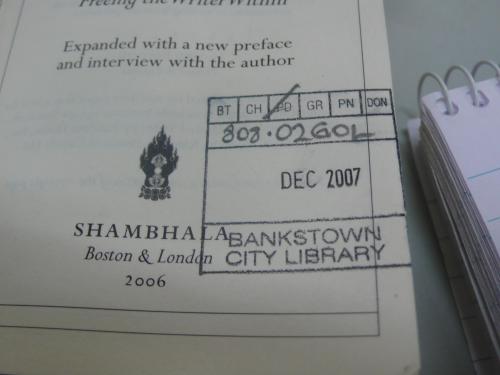
Perhaps my favourite detail in Padstow library, apart from the plants, was sign instructing patrons to look after the library books. I’d never seen such an explicit plea to be careful, and keep the books away from water, food, coffee – all the things that muck them up.

The man at the computer leaned back and stretched his arms forward, releasing the tension in his shoulders now that he had passed his test. I could see the green text on the screen announcing his success. He sat forward again, and clicked on the screen to do another practise test. No way was I sitting through that again! I left the library, pausing to take a photo of myself in the reflective windows the teenage girls had used as a mirror.

Note the grass green stockings.
I had ten minutes to wait for a train, so went on a quick search for a jam tart. Every project I do has some kind of signature food; for this project, it’s jam tarts. I am surprised, though, by the number of bakeries that don’t make them. The Padstow Bakehouse didn’t, although it did have a pleasingly faded sign and window display. Outside the bank next door, a little boy stood holding two shiny silver fake guns, pointed at the door as if about to hold it up. I looked around for someone to laugh about this with, but no one else had noticed.

When planning which library to visit, I had decided on Padstow by a kind of automatic process, where the name just floated into my consciousness. Padstow is part of the Bankstown library family, which also includes Panania. I’d never been to Panania, and thought today would be a good day to do so. It is a few stops further on, from Padstow. What would I find there?
The rat-tail thugs outside the chicken shop made me nervous as I walked past them up towards Panania library. I didn’t know anything about Panania, and felt a sudden spark of worry that it was a “dangerous” place. Although I am wary of stereotypes and judgements of places based on their socio economic profile, the thing about Panania was that I didn’t know anything at all about it. For the people on the streets around me it was home, the centre of their universe. This is one of the things I like about exploring different places. I am an outsider in the centre of others’ universes.
The universe of Panania is one of multiple bread and fruit shops, old ladies sitting talking on park benches, council rangers with dogs on leads, the Panania Treasure Mart and its 50% off sale, and kids running wild in their front gardens, which, fenceless, overlap with the footpath. Further down the street, an old man in a tartan cap pushed a creaky petrol mower over the grass on the nature strip. He paused as I passed by, and I went to smile at him but he averted his eyes.
At one of Panania’s bakeries I found my jam tarts and strolled up to the Salvos, eating them. I have a strong op shop radar, which enables me to find them even in places I have never been to before. It was very busy in the Salvos. As I looked through the bric a brac a girl near me asked her mum if she could have the metal coin bank patterned with a $20 note she held in her hands, since her sister had one. “No,” her mum said. The girl wasn’t disappointed. “Oh well, I’m getting a book and a wig!”
Some women were standing near the counter, gossiping about a couple who’d married during a siege somewhere in the world. “He’s a good man but…” one trailed off, “not bright,” said her friend, stepping in to help.
I thought of this poor, not bright chap as I bought my Dolly Parton record from the grumpy woman behind the counter. She didn’t offer me a bag and I spend the rest of the day walking around with Dolly Parton’s Greatest Hits under my arm, feeling self conscious.
After op shopping, I went back to the library. Panania library must have been built around the time as Padstow, and in fact both of the other libraries I have been to so far – all the buildings date from around the 1960s. I peeked through the windows, and saw no one inside. Perhaps the library was closed?

When I approached the doors, though, they opened, and I stepped inside. There were people there once I looked, they appeared slowly from their bookish camouflage. Overall, though, the library had a feeling of desertion. Perhaps it was the sunny afternoon, or the lure of hanging out in front of the chicken shop, or buying wigs, but I felt sad that so few people were in Panania’s library.
It was a big library, well stocked with books, and different study areas:

Exam Style

Grandma’s House
 The Desk – note baskets, potplants, high windows…
The Desk – note baskets, potplants, high windows…
Despite the lack of patrons the staff were busy, and when I looked into the back room I saw a librarian seriously considering a construction paper cutout of a chicken. I settled down in one of the study areas with a couple of books: The True History of the Hula Hoop by Judith Lanigan (though I dislike fiction books with non-fiction titles) and Making Things Move: DIY Mechanisms for Inventors, Hobbyists and Artists by Dustyn Roberts. I like thinking about inventors, hobbyists and artists tinkering with DIY mechanisms!
I browsed these books for a while, watching a woman waiting at the counter, wallet in hand, trying to get the attention of the librarians in the back room. It took a surprisingly long time for such a quiet library. When someone did come out, they said “You have to stand by the gold rope! Otherwise we can’t see you.” There were two gold posts, a rope strung between them, mid way along the counter, near the fishtank where a black, bobble-eyed fish busily swam back and forth.
I could see the trees swaying in the wind through the inevitable strip of high windows, and felt a yearning to be outside. Two libraries in one day and the details start to become overwhelming. I flicked through the grubby books in the Book Sale area, before stepping out past the Nurse Schwarzel Memorial Fountain and the desert island reading mural, and headed towards the station.

“Izit Saint Patrick’s Day?” asked one of the chicken shop thugs as I walked past.
It’s best to make some acknowledgement to this kind of thing, rather than ignore it. It shows you are not afraid.
I looked at the pimply boy in the track suit and shook my head. “Nah,” I said, as if he had no hope of ever knowing the secrets I knew, and continued on my way.
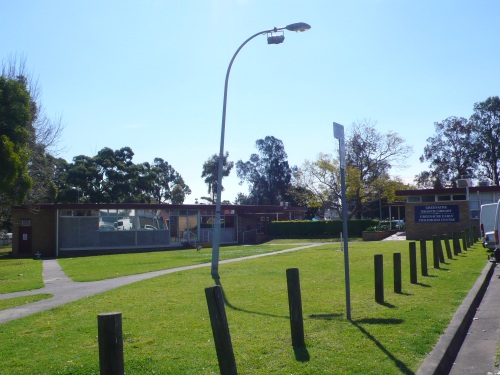 While this photograph may seem to be of a streetlight, behind it lurks Greenacre Library. Housed in a long and thin building, the library is surrounded by lawn and there is a large park behind it. It’s adjacent to the Early Childhood Centre, a common coupling of community buildings. Never have I noticed an Early Childhood Centre to be open, in my mental map of the city they are small, secret buildings that inside I imagine to be decorated in 1970s style, with lots of posters on the walls.
While this photograph may seem to be of a streetlight, behind it lurks Greenacre Library. Housed in a long and thin building, the library is surrounded by lawn and there is a large park behind it. It’s adjacent to the Early Childhood Centre, a common coupling of community buildings. Never have I noticed an Early Childhood Centre to be open, in my mental map of the city they are small, secret buildings that inside I imagine to be decorated in 1970s style, with lots of posters on the walls. I waited for a librarian dragging a large blue wheelie bin to enter the library before I stepped inside, to a conversation between librarians about the bins. Around the librarians desk were festoons of stationary available for purchase, which I have seen at no other library, but is a good idea. I once heard tell of a vending machine in a university library that sold stationery, and other things students might need that weren’t food or drinks. Being a fan of vending machines, I hoped to come across such a machine, imagining it to sell things like pens, earplugs, USB sticks, tissues, hand cream, panadol, paperclips…or just pens, as in the example below.
I waited for a librarian dragging a large blue wheelie bin to enter the library before I stepped inside, to a conversation between librarians about the bins. Around the librarians desk were festoons of stationary available for purchase, which I have seen at no other library, but is a good idea. I once heard tell of a vending machine in a university library that sold stationery, and other things students might need that weren’t food or drinks. Being a fan of vending machines, I hoped to come across such a machine, imagining it to sell things like pens, earplugs, USB sticks, tissues, hand cream, panadol, paperclips…or just pens, as in the example below.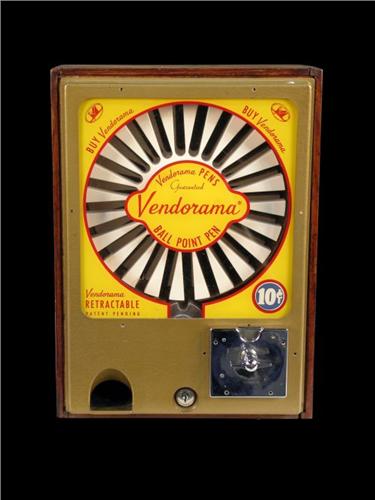 The interior of Greenacre library was easy to imagine as the interior of a ship, as the building is a slight crescent shape, and the walls are wood panelled. I imagined it floating in an ocean of lawn as I surveyed the shelves. I was drawn to the cookbooks section because of a large CWA cookbook. My interest in the CWA had been piqued by a performance art action that I’d gone to see the day before, by the Brown Council. They baked all 137 cakes from one particular CWA cookbook over 90 hours. The book they used was called ‘Jam Drops and Marble Cake’, and featured classic cakes, but the one I looked at had all courses covered. I decided to open up a page at random and see if I would cook the recipe I found there.
The interior of Greenacre library was easy to imagine as the interior of a ship, as the building is a slight crescent shape, and the walls are wood panelled. I imagined it floating in an ocean of lawn as I surveyed the shelves. I was drawn to the cookbooks section because of a large CWA cookbook. My interest in the CWA had been piqued by a performance art action that I’d gone to see the day before, by the Brown Council. They baked all 137 cakes from one particular CWA cookbook over 90 hours. The book they used was called ‘Jam Drops and Marble Cake’, and featured classic cakes, but the one I looked at had all courses covered. I decided to open up a page at random and see if I would cook the recipe I found there. It was a peaceful day in the library, a few people looking at books, a white-gloved librarian quietly putting books away in the children’s section, and a few people on the computers. I browsed around the non fiction section and got stuck on the unlikely choice of The Book of Awesome.
It was a peaceful day in the library, a few people looking at books, a white-gloved librarian quietly putting books away in the children’s section, and a few people on the computers. I browsed around the non fiction section and got stuck on the unlikely choice of The Book of Awesome.
